Below is a curated list of 2023 Gen Z trends, facts, stats, figures, and media consumption from GWI, Statista, eMarketer, Pew Research, and directly from social networks. It will be updated as new Gen Z insights and research are released. [Updated: December 05, 2023]
Gen Z relies heavily on social platforms like YouTube (65%), TikTok (43%), and Facebook (40%) when initially self-educating on banking topics, indicating that digital-first banks should strongly prioritize influencing these networks to reach future prime customers during key financial literacy moments. With 40.4 million Gen Zers in the US projected to adopt digital banking services in 2024, focusing educational content on these leading platforms provides critical opportunities to organically connect with younger audiences, opening first accounts and establishing foundational perceptions of brands (Source).
See updated 2024 Gen Z Trends
New Data: Gen Z Social Media Usage
Click here to review the Gen Z media and news consumption data below.
A new report from Insider Intelligence highlights Gen Z technology and media preferences, revealing some new insights.
TikTok, Instagram, and Snapchat consume much of Gen Z’s daily attention, with TikTok currently taking the lead. Those aged 18-24 spend an average of 58 minutes daily on TikTok compared to 38 minutes on Instagram and 30 on Snapchat.
However, Instagram is poised to overtake TikTok in 2024 regarding user penetration among this cohort, though TikTok will maintain its lead in time spent. By 2027, both platforms will continue to see strong Gen Z engagement.
Beyond entertainment, these apps are Gen Z’s primary news sources. 75% of this age group rely on social media for breaking news – more than any other generation. The highly shareable formats of TikTok, Reddit, and Twitter make staying informed effortless.
On balance, Gen Zers worldwide sees social media’s impact as positive. Its ability to connect people and enable self-expression outweighs downsides like FOMO and body image struggles.
They also don’t shun social media ads. The study found higher openness to ads on these platforms than on TV.
However, Gen Zers do occasionally unplug. They are the most likely generation to take social media breaks. But these tend to be short – under a week – given how engrained it is in their routine.
In summary, social media plays multidimensional roles for Gen Z. It’s their go-to for news, relationships, and inspiration. But the constant stimulation can be exhausting. So, while interested in moderation, fully disconnecting, even briefly, remains challenging.
Gen Z Trends At a Glance
As we navigate through 2023, understanding Generation Z’s preferences, habits, and values becomes increasingly important for marketers, educators, and society. Born between the mid-1990s and early 2010s, this generation shapes the world with its unique perspectives and digital nativity.
The following table provides a snapshot of key Gen Z trends across various domains. It offers valuable insights into their social media usage, purchase drivers, fashion and beauty trends, workplace preferences, core values, and news sources.
| Key Insights | |
|---|---|
| General Gen Z Trends | Gen Z’s preference for unique brands, their habits in watching series and movies, gaming, and traveling, their concerns about climate change, and their plans for 2023. |
| Gen Z Purchase Drivers | Gen Z’s likelihood to make purchases on Instagram, their tendency to buy products based on influencer recommendations, and their plans to shop more on Amazon in 2023. |
| Gen Z Fashion & Beauty Trends | Gen Z prefers skincare products that protect against extreme weather and sun, their openness to new fashion apparel, and their interest in vintage clothing styles. |
| Gen Z Workplace Trends | Gen Z’s openness to in-office romance, their job-seeking behavior, and their preference for hybrid or remote work. |
| Gen Z Values | Gen Z is concerned about their physical and mental health, skepticism towards people, and entrepreneurial spirit. |
| Gen Z News Sources | Gen Z’s engagement with news sources through social media, their use of TikTok for news, and their trust in people like themselves for fact-checking. |
Brands Need to Pay Attention to Gen Z
Millennial spending statistics and consumer trends have long been a focus for marketers. Still, attention is shifting towards the new generation – Generation Z. Gen Z characteristics, such as their digital nativity, desire for authenticity, and focus on social issues, are shaping their spending habits. In addition, many Gen Zers are now entering the workforce, and their influence on the market is becoming increasingly apparent.
In 2023, the Gen Z trend is towards more personalized and socially conscious brands. Their spending habits reflect a preference for brands that align with their values and utilize their preferred Generation Z social media platforms. Unlike the previous generation, they are likelier to engage with brands with a solid online presence, particularly on platforms like TikTok and Instagram.
While still a significant market force, the millennial generation is giving way to these younger generations. Generation Z’s characteristics and evolving spending habits are reshaping the market landscape. Young people, particularly Gen Zers, are not just the consumers of tomorrow but are influencing trends and shaping markets today.
Gen Z Research & Insights
The statistics below explore the multifaceted nature of Gen Z’s world. From their media consumption habits, which show a pronounced preference for platforms like TikTok, Instagram, and Snapchat, to their values and purchasing drivers, each facet reveals a generation that is both a challenge and an opportunity for marketers.
General Gen Z Trends
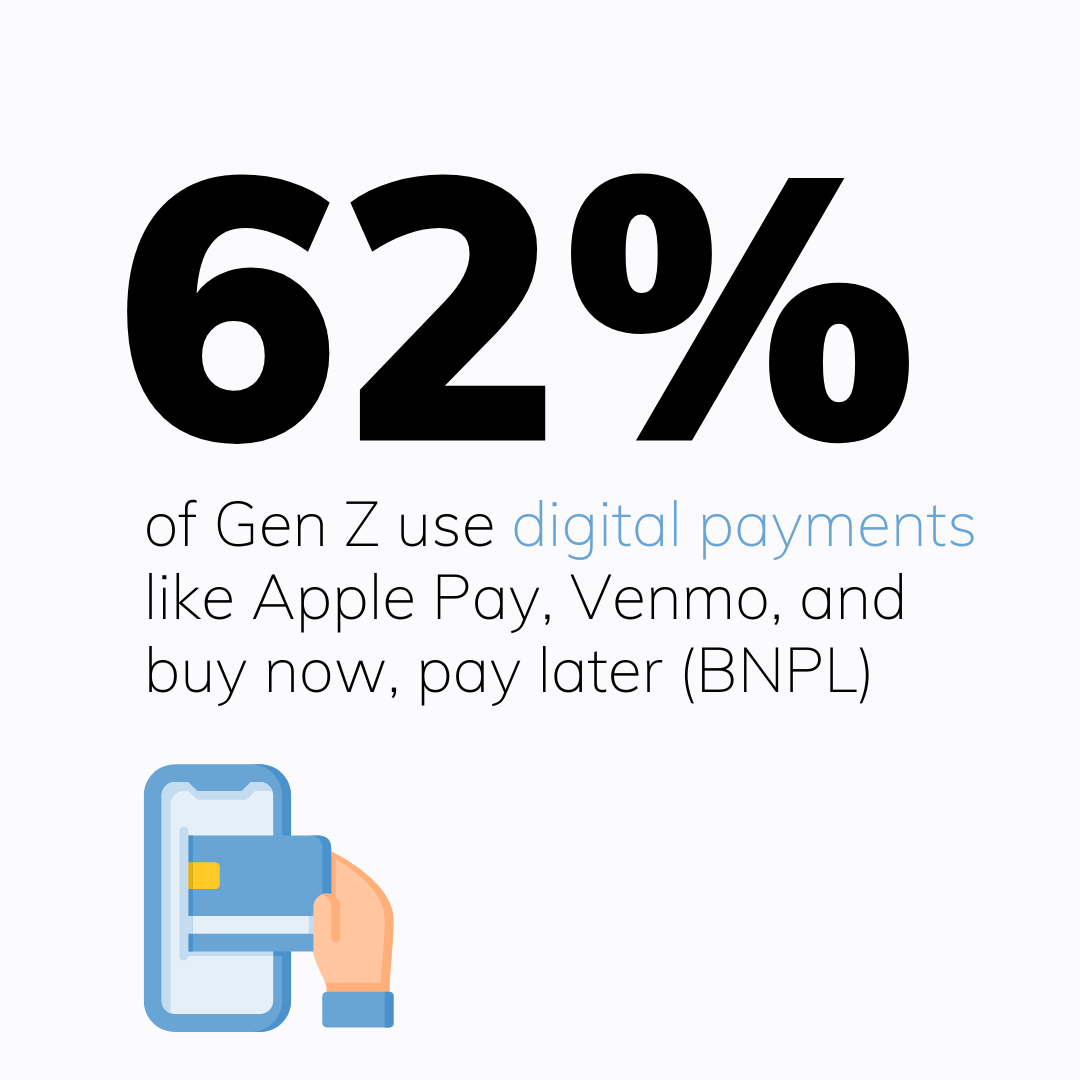
- Gen Z reports the highest stress levels on average, with the majority having trouble sleeping at least three nights weekly (Source)
- Over half of Gen Z individuals start and end their day with social media, doing so on most days (Source)
- A vast majority, approximately 87%, of Gen Z admits that reducing their screen time at night would be challenging (Source)
- 75% of the Gen Z audience wants brands to do something new and unique (Source)
- 71% of Gen Zers like to watch the same series and movies they did as kids (Source)
- 51% of Generation Z say that ads that made them smile are the most memorable (Source)
- 73% of the Gen Z audience play console games like PlayStation, Xbox, and Nintendo (Source)
- 80% of Gen Zers use streaming services (Source)
- 52% of Gen Z adults are frequent travelers, having taken at least three leisure trips in the past 12 months (Source)
- Generation Z will make up 20% of the US population in 2023 (Source)
- Gen Z will surpass Gen X in its number of US buyers by 2025 (Source)
- 62% of Gen Z use digital payments like Apple Pay, Venmo, and buy now, pay later (BNPL) (Source)
- 44% of Gen Z in the US are concerned about climate change (Source)
- 37% of Gen Z prefer a social gaming experience (Source)
- 21% of Generation Z plan to cancel their gym memberships in 2023 (Source)
- 64% of Gen Z creators plan to monetize a project in 2023 (Source)
- Over 85% of Gen Z want to learn a new skill in 2023, and 25% want to focus on finance (Source)
- Gen Z’s main cybersecurity concern is having their photos leaked online (Source)
- 56% of Gen Z adults prefer to buy from brands that have similar social values (Source)
- The number of Gen Z using the Internet for discovery has decreased by 9% year-over-year (Source)
- 69% of Gen Z chat with friends online while watching TV (56%) use social media, (and 32%) read emails (Source)
- Gen Z streams music for nearly 2 hours every day (Source)
- 56% of Gen Z adults have heard of ChatGPT (Source)
- 34% of all iPhone users are Gen Z (Source)
- Gen Z adults pay more attention to social media ads than other adult generations (Source)
Gen Z Social Media Usage Trends
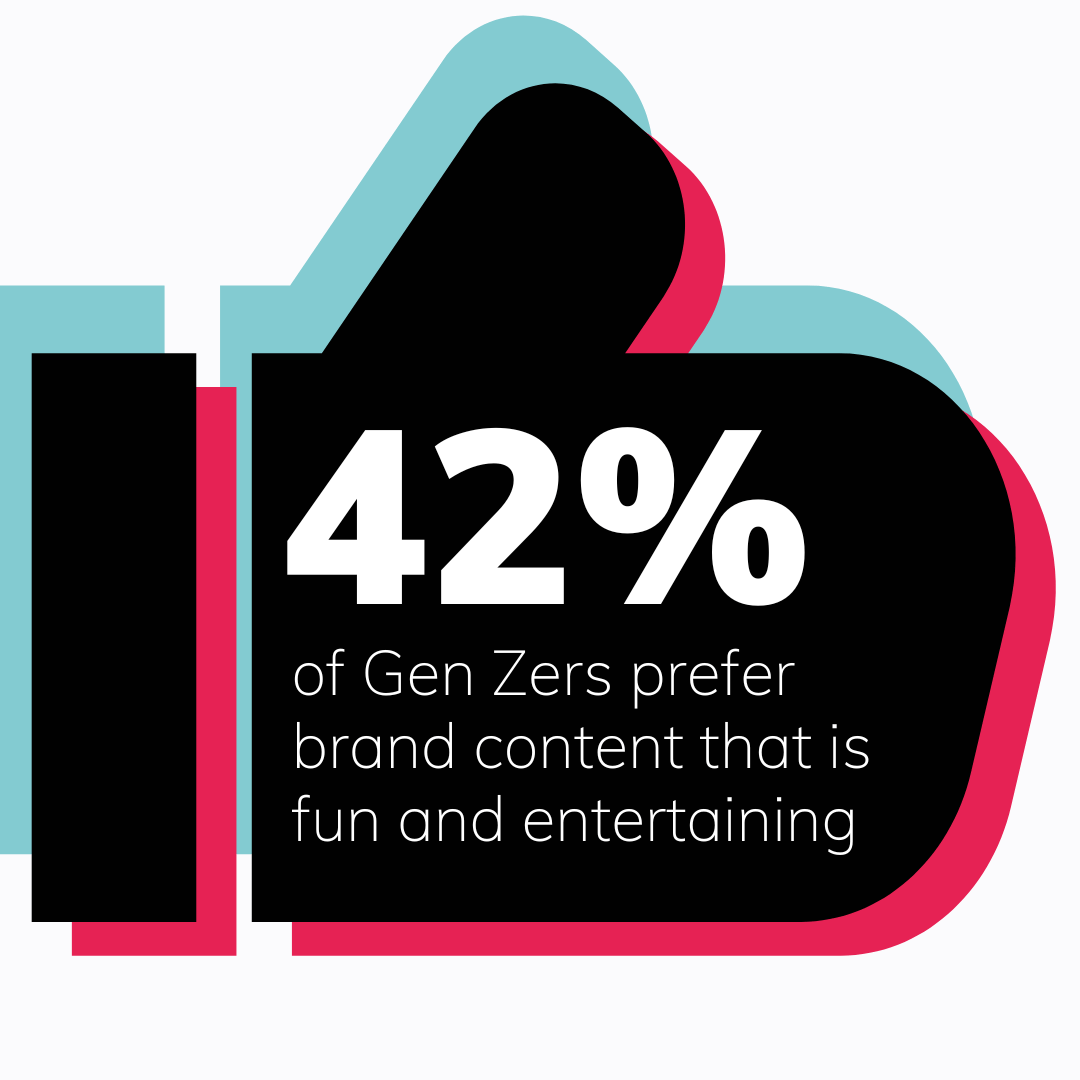
- 65% of Gen Z dislike ads that appear in the middle of games and videos (Source)
- 1 in 3 Gen Zers watch new TV series, shows, and films discovered on YouTube (Source)
- 50% of Gen Zers follow algorithmic content recommendations from social media, 44% over the in-person word-of-mouth recos (Source)
- 30% of Gen Z audiences cite social media ads are the best way to reach them online (Source)
- Gen Zers spend more time on gaming (22%) and YouTube (21%) than watching television (17%) (Source)
- 88% of Gen Z use YouTube, followed by Instagram (76%), TikTok (68%), and Snapchat (67%) (Source)
- 61% of Gen Z engage with brands on TikTok (Source)
- 42% of Generation Z prefer brand content that is fun and entertaining (Source)
- 35% of Gen Z use YouTube, TikTok, Instagram, Snapchat, or Facebook “almost constantly.” (Sources)
- 33% of Gen Z look forward to in-person experiences (creator conventions and meetups with influencers) (Source)
- 40% of the Gen Z audience want to listen to podcasts from creators in 2023 (Source)
- 32% of Gen Z are using or have used Facebook in 2022, down 39 points since 2014-15, when 71% said they used Facebook (Source)
- 40% of Gen Z use TikTok when looking for a place to eat lunch (Source)
- 60% of Gen Z use social media for research and discover information (Source)
- 22% of Gen Zers “highly” trust the information on social media, yet it is ranked second in platform loyalty (Source)
- 37% of Gen Z adults are not familiar with the metaverse (Source)
- Gen Zers spend 2 hours and 53 minutes on social media every day (Source)
- 2 in 5 Gen Zers have a fondness for ’90s music & entertainment (Source)
- 22% of Gen Zers trust social media “highly,” despite ranking second in platform loyalty (Source)
Gen Z Purchase Drivers
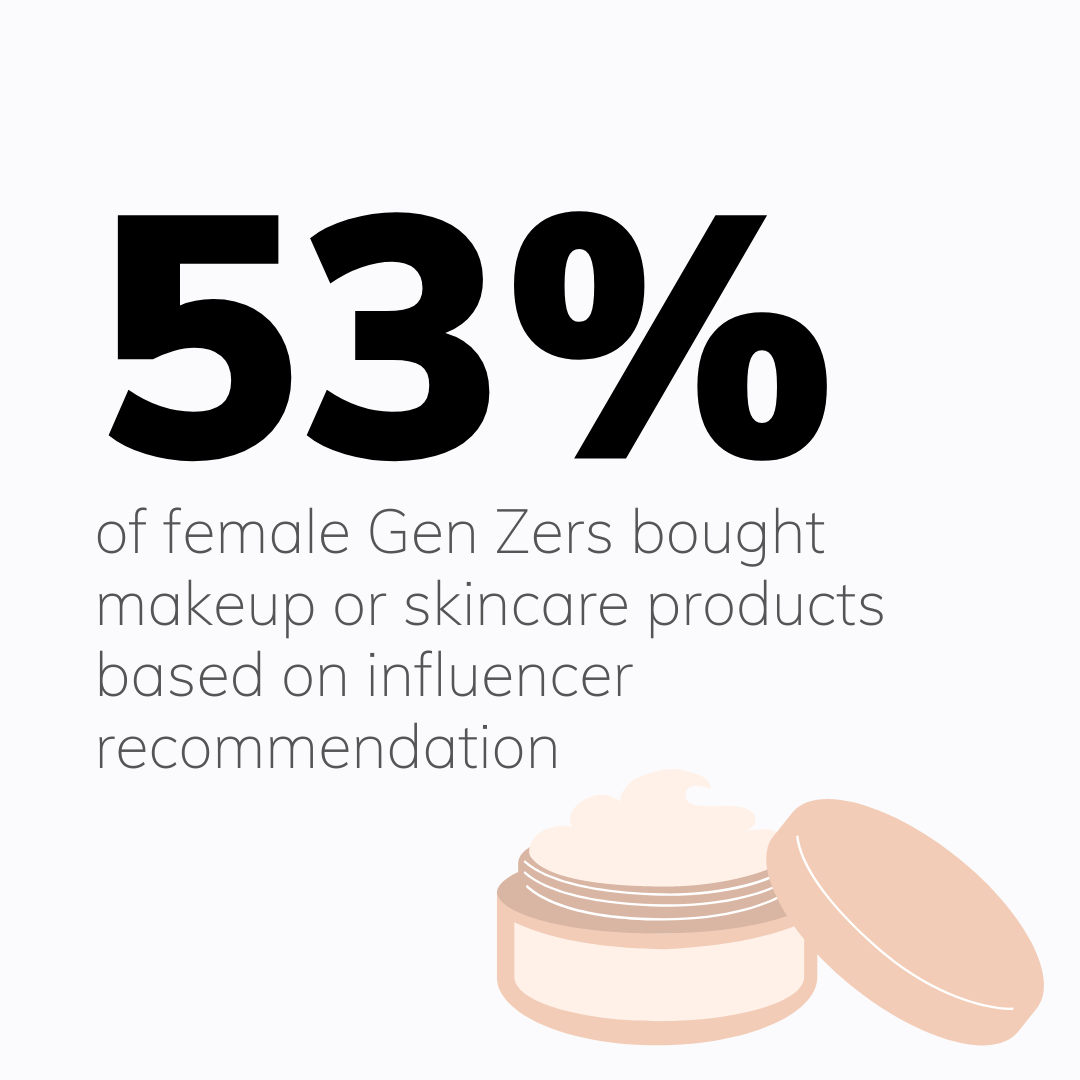
- 71% of Gen Zers in the U.S. say they are likely to make a purchase directly on Instagram (Source)
- 53% of female Generation Z bought makeup or skincare products based on a recommendation from an influencer (Source)
- 19% of Gen Z discover new brands and products through influencer posts and blogger reviews (Source)
- 50% of Gen Z actively search for information about brands, products, or services on social media sites (Source)
- 25% of Gen Z are likely to buy a product if it has lots of “likes” or positive comments on social media (Source)
- 24% of Gen Z plan to shop more on Amazon in 2023 (Source)
- 42% of Gen Z buy products directly through TikTok (Source)
- Among TikTok users, 46% of Gen Z make impulse purchases on the Internet every 2-3 weeks (Source)
- 77% of Gen Z adults openly try new brands within the grocery, apparel, and beauty categories (Source)
- 50% of Gen Z use social media to discover new products and research information (Source)
- YouTube is the top social channel that Gen Z uses for researching products, followed by Instagram, Facebook, and TikTok (Source)
- 59% of Gen Zers believe that Instagram ads influence their purchases more than TikTok (57%), Facebook (36%), and Twitter (29%) (Source)
- 63 % of the Gen Z audience say they click on video ads more than any other format (Source)
- 42% of Gen Zers follow and buy from brands on TikTok (Source)
Gen Z Fashion & Beauty Trends
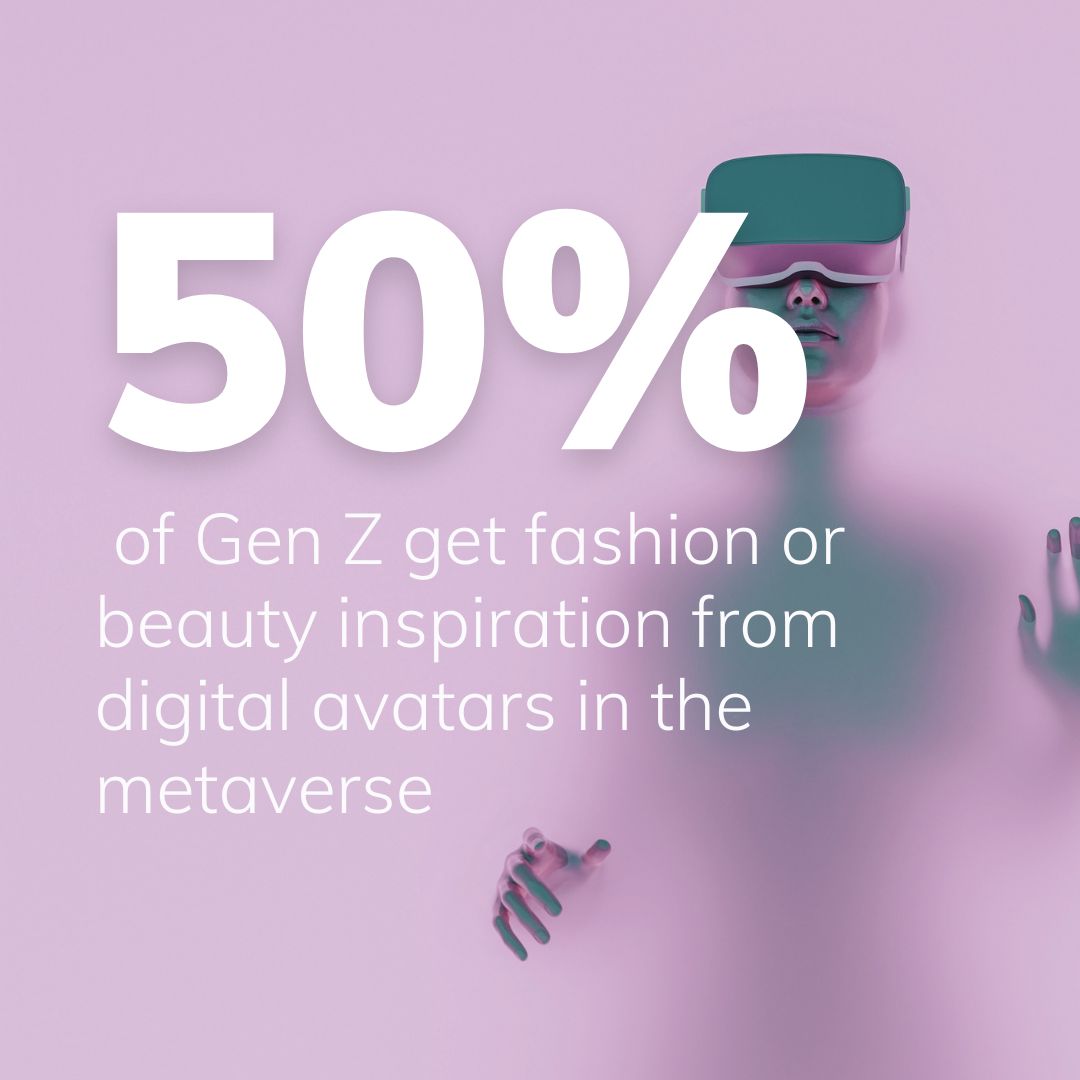
- Gen Z in the US considers DE&I to be more important than fashion or reputation (Source)
- 66% of Gen Z shoppers plan to buy skincare products that protect against extreme weather and sun. (Source)
- Over 50% of Gen Z get fashion or beauty inspiration from digital avatars in the metaverse (Source)
- Gen Z women are more open to new fashion apparel than make Gen Zers (Source)
- 54% of Gen Z like vintage clothing styles, with many trends from the 90s and Y2K coming back in popular demand (Source)
- 41% of Gen Z want retailers to offer more inclusive sizes, and 38% want to see more diversity of body types in ads (Source)
- 33% of Gen Z women perceive that meeting society’s beauty standards is only achievable through cosmetic procedures, highlighting the impact of societal norms on body image perceptions (Source)
- Gen Zers are 2.6x more likely to buy new clothes every week compared to other generations. This data reveals that the younger generation has a greater tendency to purchase clothes weekly than their older counterparts. (Source)
Gen Z Workplace Trends
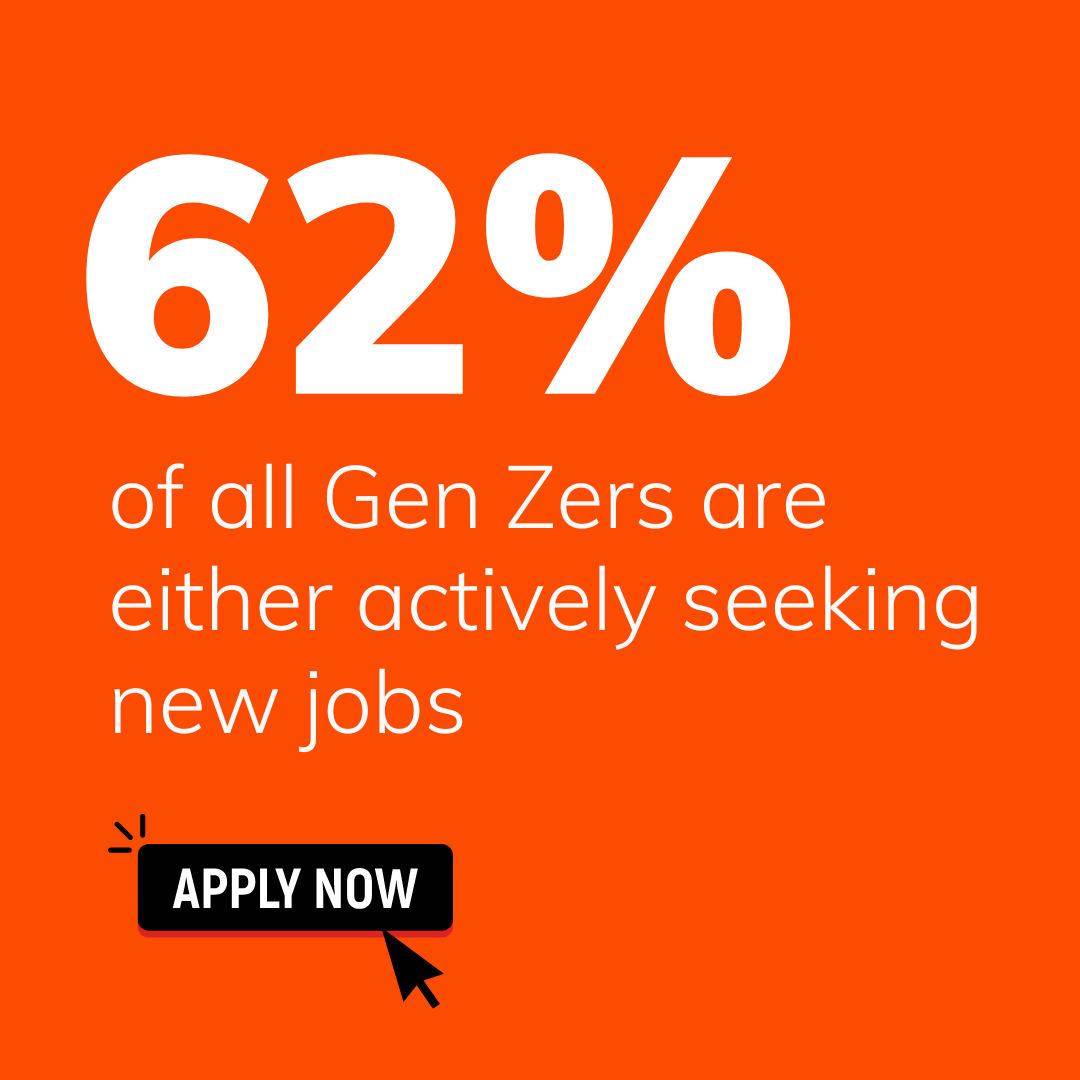
- 33% of Gen Z and younger millennials are more open to an in-office romance than older generations (Source)
- 62% of Gen Z are actively or passively seeking new jobs (Source)
- 70% of Gen Z say they are loyal to their employer but are still seeking new opportunities (Source)
- 45% of Gen Z have side hustles (Source)
- 78% of Gen Z say the lack of transparency is the biggest pain point in recruiting (Source)
- 85% of Gen Z prefer hybrid or remote work (Source)
- 37% of Gen Zers say their education does not prepare them with the tech skills they need in the workplace (Source)
- 44% of Gen Zers say they only learned very basic computing skills in college (Source)
- 4% of Gen Z are likely to start their own business (Source)
- 34% of Gen Zers expect more out of work than they used to (Source)
Gen Z Values
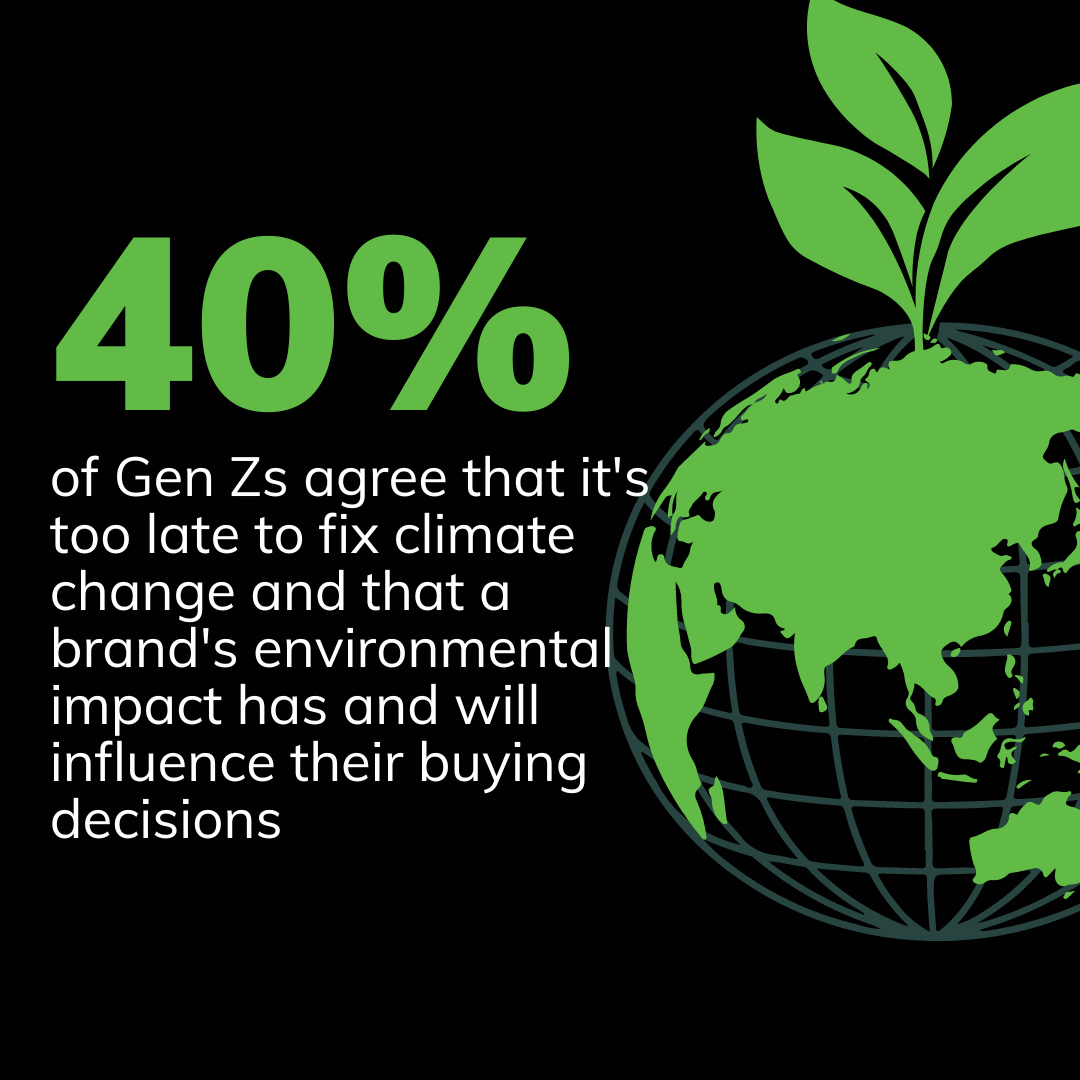
- 84% of Gen Z want to be connected with like-minded people and to be part of a group “like me” (Source)
- Only 15% of Gen Zers want to be a part of a popular group (Source)
- 60% of Gen Zers care more about their mental health than how they look physically (Source)
- 40% of Gen Zs agree that it’s too late to fix climate change and that a brand’s environmental impact has and will influence their buying decisions (Source)
- 3% of Gen Z have taken PTO due to pandemic stress (Source)
- 40% of Gen Z aren’t convinced that their employers care about their mental health (Source)
- 46% of Gen Z are constantly stressed out (Source)
- 66% of Gen Z view wealth and income as unfairly distributed (Source)
- 56% of Gen Z believe systemic racism is real in US culture (Source)
- 20% of Gen Z have felt discriminated against in different situations (Source)
- Gen Z is very confident that social progress will be made regarding the LGBTQ community (85%), gender inequality (79%), and economic equality (68%) (Source)
- 46% of Gen Z see their appearance as part of their identity in the real world (Source)
- 28% of Gen Zers feel their virtual avatar needs to reflect their physical features (Source)
Gen Z News Sources
Watching TikTok and YouTube videos isn’t the only way Gen Z will consume media. According to this research, 35% of Gen Z adults read more today than in 2020, and 67% read it on their phones. Gen Z news sources will undoubtedly change from year to year, but here’s a snapshot of where they are now.
- 43% of Gen Z engage with news sources through sharing on social media, texting and emailing friends and family, or commenting on an article at least once a day (Source)
- 38% of Gen Z actively seek out news media content in different ways (Source)
- 15% of Gen Zers get their news from TikTok (Source)
- 66% of Gen Z get their news through push notifications (Source)
- 60% of Gen Zers use social media for information, more than the Internet and twice as much as print or digital media (Source)
- Gen Zers trust people like themselves twice as much as mainstream news for fact-checking (Source)
- 57% of Gen Zers strongly agree that social media is more convenient for news consumption than internet searches, websites, or apps (Source)
Gen Z Media Consumption (Business Media)
The data below represents 250K self-identified Gen Z social media users. The data is plotted by affinity–the percentage of the audience that follows the business media outlet on social media. The data is compared to Gen Pop (a random sample of social media users) to understand which media outlets they over or under-index
Below are the top business media outlets consumed by Gen Z. What’s interesting about the data is that Gen Z under-indexes across most of these outlets, except for The Washington Post and CBS News.
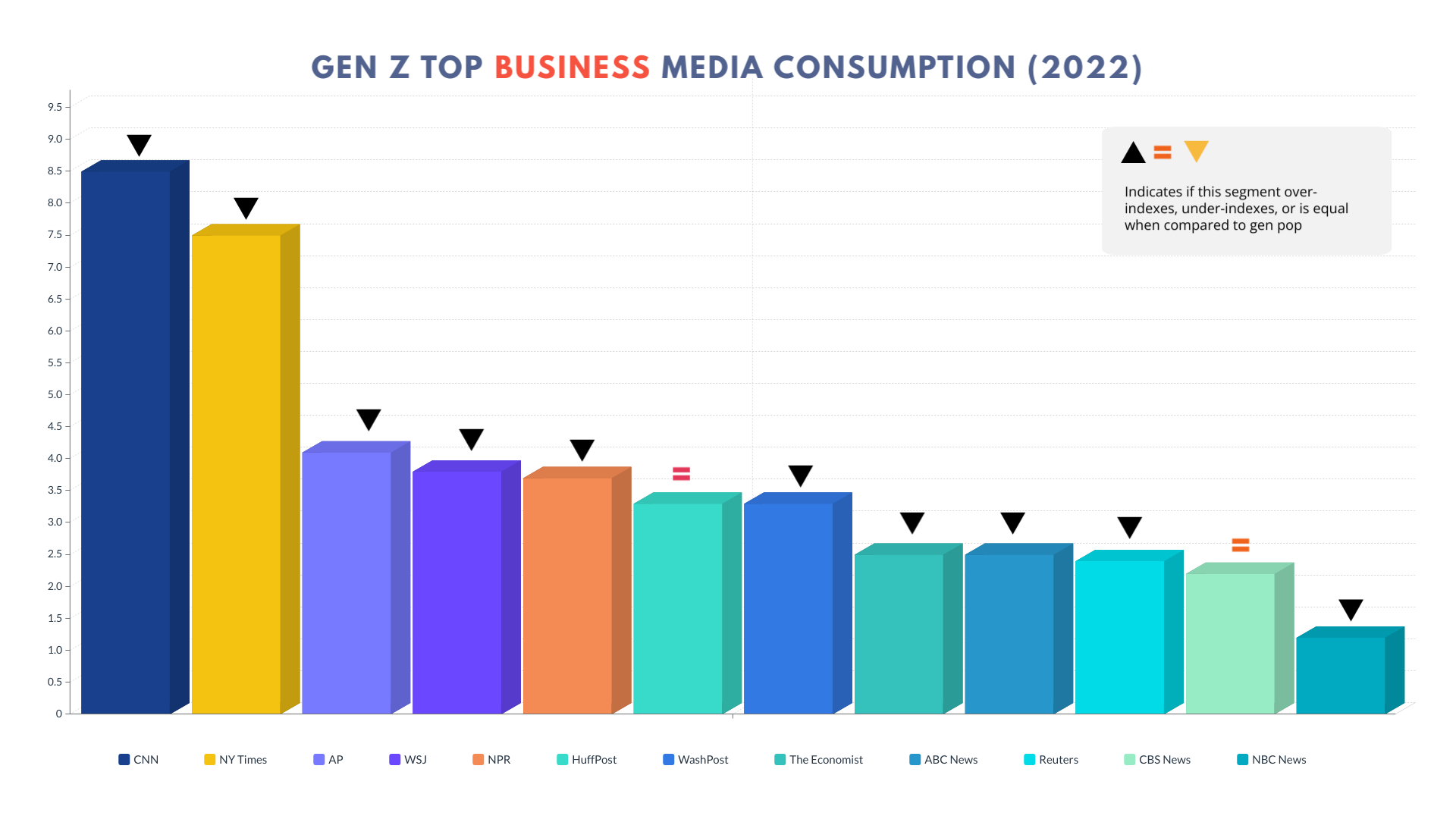
Gen Z Media Consumption (Consumer Media)
Below are Gen Z media consumption of consumer outlets. The data tells a slightly different story when compared to business media. Compared to GEN pop, Gen Z over-indexes in media consumption of E! News, People, TMZ, Rolling Stone, Us Weekly, and Elle. They under-index in media consumption of TODAY, Good Morning America, Vanity Fair, and Men’s Health.
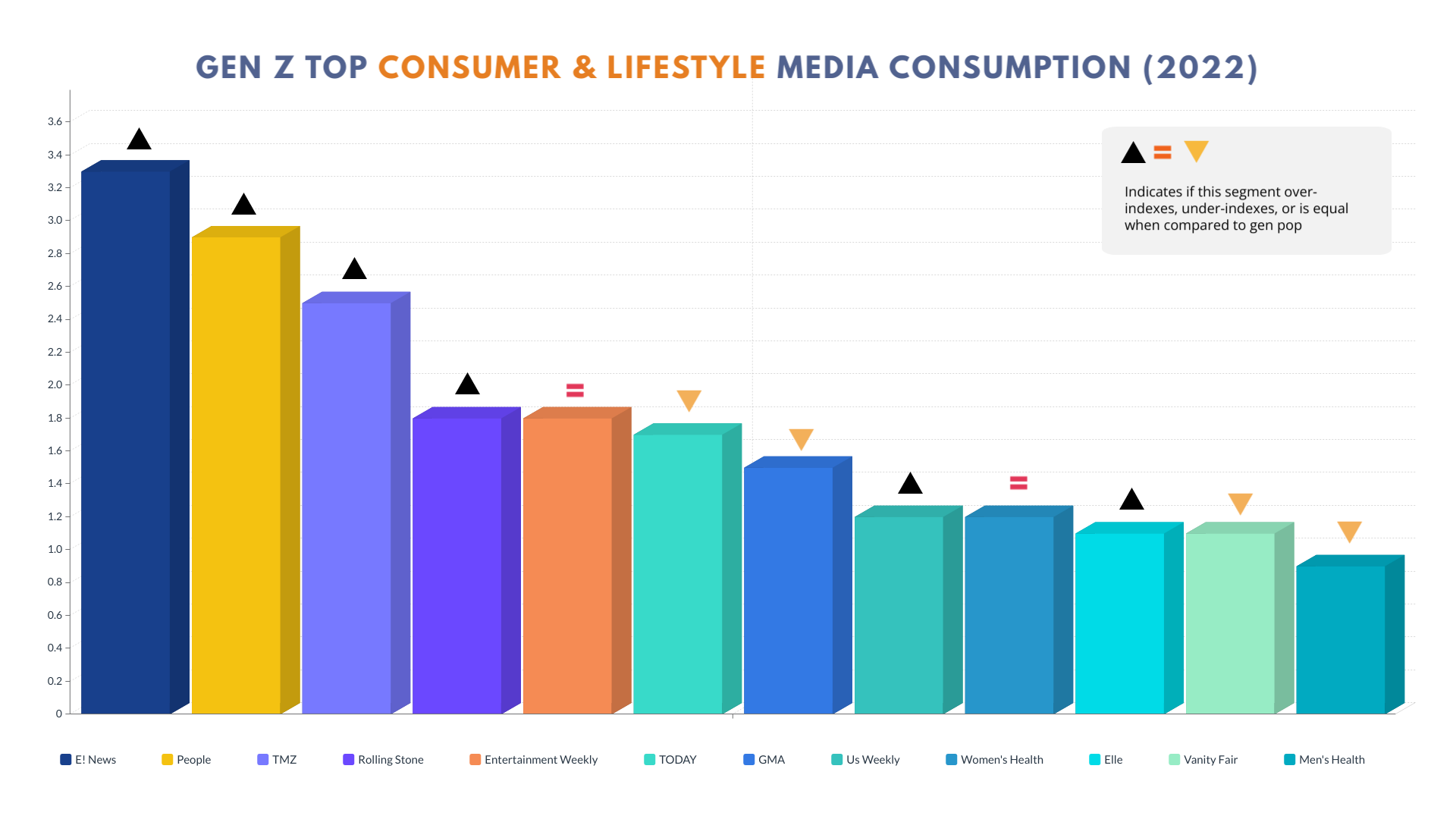
Gen Z Shopping Habits
The Gen Z audience is here and taking over the world. They are racially and ethnically more diverse than every other generation. But, while millennials are considered the generation of digital natives, most Gen Zers don’t remember life before the Internet, their iPhones, or Instagram.
It’s estimated that the Gen Z audience represents about $143 billion in annual purchasing power. This does not include the products and services their parents and family paid for. According to Oxford Economics, Gen Z’s purchasing power will reach $2 trillion in less than ten years.
If these two data points aren’t enough to motivate you to start thinking about Gen Z trends, I’m not sure what will.
Marketing and PR teams must focus on Gen Z media consumption, trends, and purchasing habits. This generation is already making waves culturally, and their shopping habits will significantly impact the future of retail. Previous generations like Baby Boomers, Gen X, and Millennials have always influenced the economy, innovation, and how brands create products, communicate with customers, and set prices.
Gen Z is already doing this, and their impact is record-setting. As a result, brands must get a head start understanding how they shop, where they shop, and what they are talking about on their digital channels.
The Gen Z audience represents a lucrative opportunity for brands that can connect with them and influence their shopping habits. This generation is known for being savvy and resourceful in using social and digital apps. They are also highly independent and value transparency.
Gen Z’s Values & Beliefs
In November 2021, EY released its second iteration of the 2021 Gen Z Segmentation Study, which tracks Gen Z trends, beliefs, and perspectives on issues from mental health, social issues, and the workplace. It should be noted that this report was facilitated during the height of the pandemic.
It’s widely known that Gen Z consumers are the most diverse generation and are very opinionated about the world, businesses, and societal issues. Therefore, brands must try and understand this generation to build products and experiences that align with their values.
Key insights from the study include:
- Mental Health is an Issue: 67 percent of Gen Zers are worried about their physical and mental health, with 42% feeling depressed during the pandemic. Nineteen percent of the Gen Z audience also said they did not receive emotional support from friends and family during this time.
- Gen Zers Are Skeptical: 60 percent of Gen Z believe that most people can’t be trusted and are selfish, only caring about themselves and their needs.
- Gen Z is Worried: 69 percent of Gen Z are worried about food shortages due to the pandemic, and 28 percent are concerned about losing their job during this period.
- The Gen Z Audience is Entrepreneurial: 45 percent of Gen Z are likely to start their own business.
- Change is Good, and Gen Z is ready for It: Gen Z is very confident that social progress will be made regarding the LGBTQ community (85%), gender inequality (79%), and economic equality (68%).
Understanding Gen Z’s values and beliefs is critical for brands that want to connect with them. They are a generation open to change and want to see progress globally, so brands need to be transparent and authentic to earn their trust. Several studies show the top US brands are the ones that share the same values as their customers.
Gen Z Audience: All Are Not Equal
There are thousands of ways to segment an audience. Marketers have been doing this for years and Use the insights to create audience personas. Historically, segments were built using Primary research, a series of questions a marketer asks to drill down on a predefined hypothesis. So, every report you see about Gen Z trends has an element of bias, and that’s OK. A good marketer will consider more than one data source to try and understand an audience or solve a marketing problem.
Identifying Five Gen Z Audience Segments
We built our own Gen Z segments using social analytics and affinity data. Some of these insights and segment descriptions might seem contradictory to the above values from the EY study, and that’s OK. This data is about who/what they follow online and what they are talking about on social.
The five key Generation Z segments we found are:
- Life Lovers
- Growth Hacking & Tech
- Hip Hop Creators
- TwitchTok’ers
- Sports & Hooplife
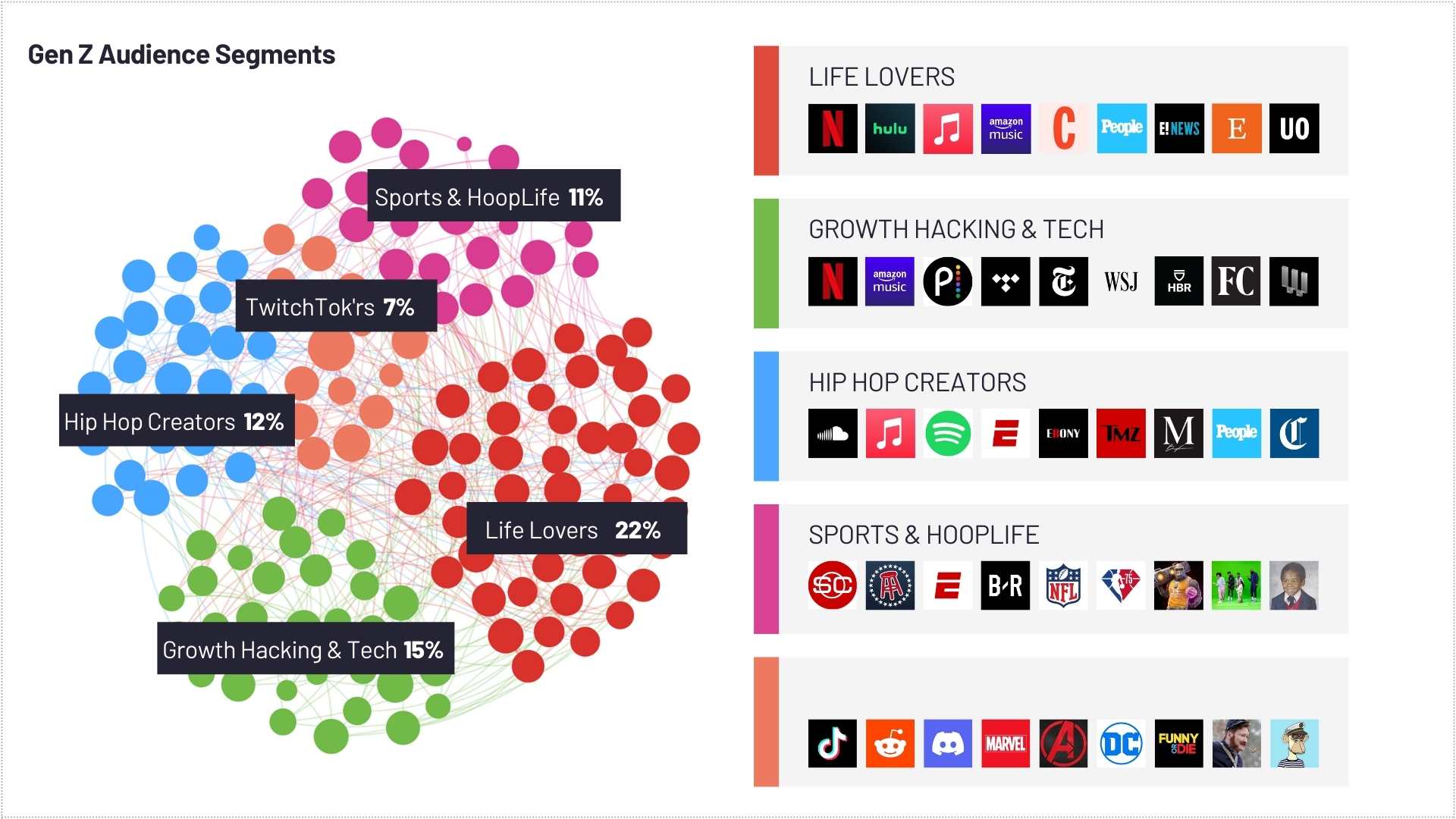
Life Lovers Segment
The Life Lovers audience segment is 72.4 percent female. They are incredibly optimistic and look at the positive side of everything. The top three keywords in their bio are love (9.7%), life (6.3%), and life (4.5%). The most common names for Gen Z consumers are Jessica, Sarah, and Amanda.
They are fans of most video streaming services, except for Peacock. In that order, their top three music streaming services are Apple Music, Amazon Music, and Spotify.
Their “go-to” outlets when it comes to media are People Magazine, Vogue, TMZ, Us Weekly, and Cosmopolitan. In addition, they read Huffington Post, CBS News, and the New York Times for business-related media. Finally, this segment’s preferred shopping brands are Urban Outfitters, Etsy, and Forever 21.
Growth Hacking Tech Segment
The Growth Hacking & Tech audience segment is 58 percent male. The top keywords in their bio are enthusiast, tech, and marketer. The most common Gen Z names are biblical, with Michael, David, and John being the most popular.
Netflix and Amazon Prime Video are their two top streaming services. Unlike the Love Love Gen Zers, this segment does have an affinity for Peacock Streaming. Apple Music, Spotify, and Amazon Music are their top three music streaming services. However, this segment also listens to Tidal, which has a unique affinity compared to the other Gen Z segments.
Their top media outlets are The New York Times, The Wall Street Journal, The Economist, and Forbes. The three most unique media outlets they follow are The Atlantic, Harvard Business Review, and Fast Company.
Hip Hop Creators Segment
The Hip Hop Creators segment is split evenly, with 51 percent male and 49 percent female. This segment is primarily located in Atlanta, Chicago, and Los Angeles. Their top bio keywords are music, IG, and artist.
Music is one of their top interests, specifically Hip Hop, with rappers like Wiz Kalifa, Lil Wayne, TI, and J Cole being their primary affinities.
This segment is very similar to the others for streaming services, with one exception. Soundcloud is their top streaming audio platform, followed by Apple Music, Amazon Music, and Spotify.
Their top media outlets range from sports, entertainment, and business. ESPN, CNN, TMZ, The New York Times, and People are their top media outlets. Maxim, Ebony, and Essence are unique media compared to the entire audience.
TwitchTok Segment
The TwitchTok’rs audience segment is also evenly split between males and females. There isn’t anything unique about what they watch and listen to online or through their apps for streaming services.
This segment over-indexes using Twitch to stream, create, and consume content. They are also heavy users of TikTok, Reddit, and Discord. They also have very high affinities for late-night shows and comedy, with Funny or Die, The Onion, and The Tonight Show ranking in their top interests. They also have a high affinity for Jimmy Fallon, Conan O’Brien, Ellen DeGeneres, and Stephen Colbert.
Another unique factor is their love for superheroes. Compared to the Gen Z audience, they over-indexed in their love for the Avengers, DC, and Marvel Entertainment.
Sport & Hooplife Segment
The Sports & HoopLife audience segment skews 83 percent male. Their love for “all things” sports sets them apart from the larger Gen Z audience. Basketball, Baseball, and Football are their top three interests in this category.
Their top media outlets are SportsCenter, ESPN, Bleacher Report, and Barstool Sports. In addition, they have a very high affinity for Stephen A. Smith and ESPN analysts Adam Schefter and Adrian Wojnarowski.
The top athletes they follow are LeBron James, Kevin Durant, Shaq, Kobe, and Dwayne Wade.
Outside of sports, this audience reads The New York Times, The Wall Street Journal, Forbes, Men’s Health, Rolling Stone, and Vice. In addition, some unique media outlets include Outdoor Life, American Rifleman, Cord Cutter News, and Field & Stream.
FAQ
Gen Z is the generation that follows Millennials and is born between the mid-1990s and early 2010s. They are digital natives who have grown up with the Internet and social media as essential components of their lives.
Generation Z is unique in its adaptability to rapid technological advancements, strong emphasis on individuality, and heightened social awareness. As a result, they are more likely to prioritize authenticity and personal connections when engaging with brands, making them a discerning audience for marketers.
Generation Z values transparency, sustainability, and social responsibility. Therefore, companies that commit to these values are more likely to resonate with this audience by seeking brands that align with their beliefs and principles.
Gen Z gravitates toward social media platforms like Instagram, Snapchat, and TikTok, emphasizing visual content and real-time engagement. Therefore, marketers should consider these platforms when crafting campaigns targeting this demographic.
To connect with Generation Z, marketers must prioritize authenticity, relatability, and social responsibility. This can be achieved through smart creator partnerships and purpose-driven campaigns that showcase a brand’s commitment to positively impacting the world.
Influencer marketing is particularly effective for engaging Generation Z, as they often look to influencers for product recommendations and lifestyle inspiration. By partnering with influencers who share their target audience’s values, brands can establish trust and credibility with this discerning demographic.
Mobile optimization is crucial when targeting Generation Z, as they are more likely to access the Internet and engage with smartphone content. Therefore, ensuring that websites and marketing materials are optimized for mobile devices can significantly improve this audience’s user experience and conversion rates.
Related Content
